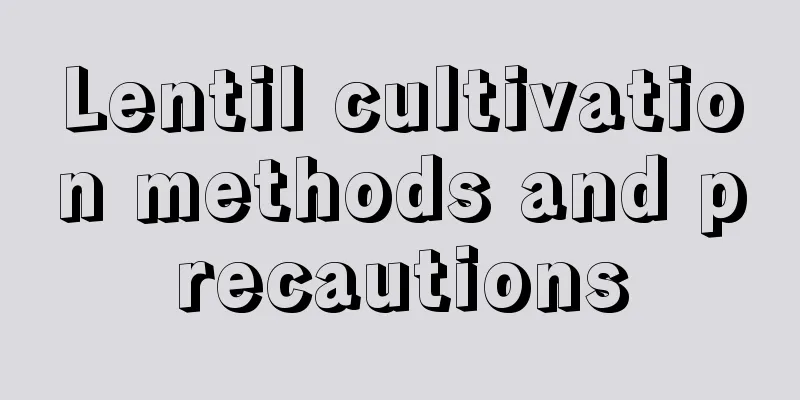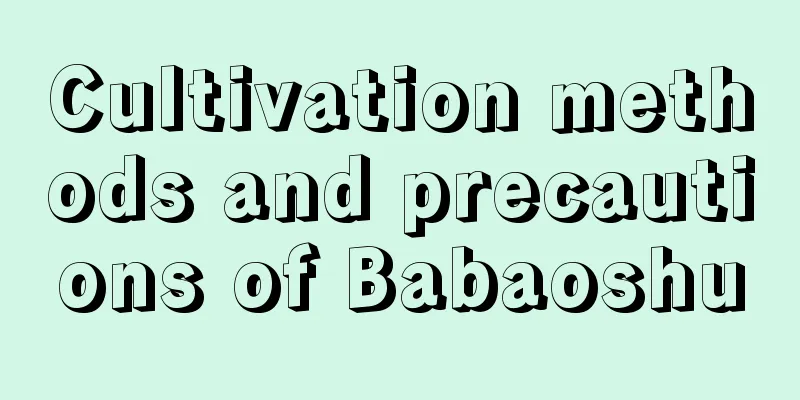Lentil cultivation methods and precautions

1. Maintenance methods1. Temperature: It likes a warm living environment and can withstand high temperatures. It grows best when the temperature is 20 degrees. If the temperature is too high, the branches and leaves of lentils will droop, and in severe cases, the branches and leaves will dry up. If the temperature is too low, the plant will grow slowly. Therefore, it is necessary to control the maintenance temperature when the plant is growing. 2. Watering: A lot of water is needed in the early stages of maintenance, and the soil should be kept moist for a long time, but watering should be appropriate. Excessive watering will cause it to grow too tall. Its roots grow very vigorously, especially during the flowering and fruiting periods. It is necessary to increase watering appropriately to promote plant growth. 3. Fertilization: If you are sowing in pots, you need to apply enough base fertilizer on the seedbed during sowing. When transplanting and planting, you need to mix compound fertilizer and diammonium phosphate into the soil. This is to ensure that the plant seedlings have all the nutrient needs. After the beginning of autumn, you need to apply top dressing once to increase nutrients and promote the growth of pods. 4. Light: It needs a lot of light to grow. If conditions permit, it is best to receive full-day sunlight. If full-day sunlight is not possible, the daily exposure time must be guaranteed to be at least six hours. 2. Breeding techniques1. Reproduction: It can be propagated by sowing. Select seeds that are large and full without disease or insect spots, dry them in the sun for 48 hours, and then prepare pots for sowing. The sowing time is generally at the end of February. About 1,000 pots are needed per acre of land. The seeds need to be watered sufficiently before sowing, with two seeds in each pot. After planting, just cover them with fine mud. 2. Build the frame: When the bean sprouts start to spin, you need to start building the frame. Insert a bamboo pole next to each hole, and build the seedlings in two holes into a herringbone shape. Then reinforce the base of the bamboo pole to prevent it from being blown away by the wind. 3. Problem Diagnosis1. Pests: The field is more susceptible to aphids in the early stage, and 10% of the net should be sprayed on the plants per acre. 2. Pathology: The plant is susceptible to downy mildew, which requires the use of methyl thiophanate for prevention and treatment. IV. Other issues1. Edibility: It is edible, but immature and uncooked plants are poisonous, so be sure to eat cooked pods. 2. Other values: It can also be used as medicine. |
<<: Cultivation methods and precautions of Chinese potherb mustard
>>: Cultivation methods and precautions of Atractylodes lancea
Recommend
What plants can purify the air indoors?
Chlorophytum Chlorophytum has a strong purificati...
What to do if there are black spots on the leaves of green radish
1. Medication When the cultivated green radish is...
How to plant hyacinth seeds
1. Autumn seed selection The climate in autumn is...
How to prune the branches and leaves of a small fortune tree? How to prune and shape it beautifully
It is best to prune the small money tree in sprin...
The flowers you grow never grow well? Use "it" to make fertilizer, the leaves are lush and shiny
What kind of fertilizer do you usually use for pl...
The efficacy and function of radix scutellariae
1. Main effects 1. Its first function is to remov...
Which month is best for sowing lentils?
Hyacinthus lentil , also known as black-eyed pea ...
What does yellow rose mean?
1. Flower Language The flower language of yellow ...
The difference between the use of potassium permanganate and carbendazim
Use of potassium permanganate and carbendazim Whe...
How to grow comfrey
1. Maintenance methods 1. Temperature: Comfrey do...
Can daffodils be grown in the south? How to grow them?
1. Can it be planted? It prefers a relatively coo...
Characteristics of Parthenocissus tricuspidata, brief introduction of Parthenocissus tricuspidata
1. Introduction to Parthenocissus tricuspidata Iv...
How to grow peach egg into old piles and cliff piles
1. How to grow peach egg into an old pile 1. Flow...
How to grow Dieffenbachia
1. Breeding conditions 1. Soil: Dieffenbachia lik...
Best time to plant cypress trees
Cypress is an evergreen tree of the genus Platycl...









